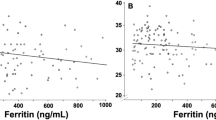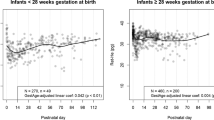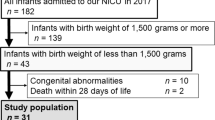Abstract
BACKGROUND: The incidence of transient reductions in serum free T4 (FT4) in premature infants may be overestimated because certain FT4 analytical methods underestimate FT4 concentrations. Transient reductions of FT4 measurements have been reported in the majority of premature newborn infants. Direct equilibrium dialysis (DED) does not underestimate FT4 concentrations and is the best available technique to measure serum FT4 in the premature infant.
OBJECTIVE: To evaluate the incidence of low FT4 concentrations in premature infants using DED to measure FT4.
DESIGN/METHOD: We measured FT4 by DED in infants with birth weight <1500 g. Infants were excluded if the following conditions were present: congenital anomalies or maternal thyroid disorders. Free T4 was measured at 14 days of life. Low FT4 was defined using a statistical definition of FT4 measurements <10.3 pmol/l (0.8 ng/dl).
RESULTS: Free T4 was measured by DED in 114 infants. Low FT4 levels were seen in nine infants (7.9%).
CONCLUSION: The incidence of low FT4 was much lower than previously reported when FT4 was measured using DED indicating that methodological issues are involved in the variability among estimates of the frequency of transient reduction in FT4.
This is a preview of subscription content, access via your institution
Access options
Subscribe to this journal
Receive 12 print issues and online access
$259.00 per year
only $21.58 per issue
Buy this article
- Purchase on Springer Link
- Instant access to full article PDF
Prices may be subject to local taxes which are calculated during checkout

Similar content being viewed by others
References
Biswas S, Buffery J, Enoch H, et al. A longitudinal assessment of thyroid hormone concentrations in preterm infants younger than 30 weeks' gestation during the first 2 weeks of life and their relationship to outcome. Pediatrics 2002;109:222–227.
Leviton A, Paneth N, Reuss ML, et al. Hypothyroxinemia of prematurity and the risk of cerebral white matter damage. J Pediatr 1999;134:706–711.
Reuss ML, Paneth N, Pinto-Martin JA, Lorenz JM, Susser M . The relation of transient hypothyroxinemia in preterm infants to neurologic development at two years of age. N Engl J Med 1996;334:821–827.
Mercado M, Yu VY, Francis I, Szymonowicz W, Gold H . Thyroid function in very preterm infants. Early Hum Dev 1988;16:131–141.
van Wassenaer AG, Briet JM, van Baar A, et al. Free thyroxine levels during the first weeks of life and neurodevelopmental outcome until the age of 5 years in very preterm infants. Pediatrics 2002;110:534–539.
Adams LM, Emery JR, Clark SJ, Carlton EI, Nelson JC . Reference ranges for newer thyroid function tests in premature infants. J Pediatr 1995;126:122–127.
Paul DA, Leef KH, Stefano JL, Bartosheshky L . Thyroid function in very low birth-weight infants with intraventricular hemorrhage. Clin Pediatr 2000;39:651–656.
Frank JE, Faix JE, Hermos RJ, et al. Thyroid function in very low birth weight infants: effects on neonatal hypothyroidism screening. J Pediatr 1996;128:548–554.
Nelson JC, Clark SJ, Borut DL, Tomei RT, Carlton EI . Age-related changes in serum free thyroxine during childhood and adolescence. J Pediatr 1993;123:899–905.
Fuse Y, Shimizu M, Uga N, Fujii T, Irie M . Maturation of feedback control of thyrotropin in premature infants. J Dev Physiol 1990;14:17–22.
van Wassenaer AG, Kok JH, Dekker FW, de Vijlder JJ . Thyroid function in very preterm infants: influences of gestational age and disease. Pediatr Res 1997;42:604–609.
Rooman RP, Du Caju MV, De Beeck LO, et al. Low thyroxinaemia occurs in the majority of very preterm newborns. Eur J Pediatr 1996;155:211–215.
Hsu CH, Chang JH, Lee YJ, et al. Thyroid function in the sick very low-birth-weight infants. Acta Paediatr Taiwan 1999;40:237–242.
Kodama S, Mori Y, Miyoshi M, et al. Thyroid function in premature infants. Kobe J Med Sci 1992;38:109–116.
Hirano T, Singh J, Srinivasan G, Pildes R . Post-natal thyroid function in low birth weight infants; a longitudinal assessment of free thyroxine and thyroid hormone binding globulin. Acta Endocrinol (Copenh) 1985;110:56–60.
Cuestas RA, Engel RR . Thyroid function in preterm infants with respiratory distress syndrome. J Pediatr 1979;94:643–646.
Polk DHFD . Disorders of the thyroid gland In: Taeusch HW, Ballard RA, editors. Avery's Diseases of the Newborn. 7th ed. Philadelphia, PA: WB Saunders, Co., 1998.
Nelson JC, Tomei RT . Dependence of the thyroxin/thyroxin-binding globulin (TBG) ratio and the free thyroxin index on TBG concentrations. Clin Chem 1989;35:541–544.
Nelson JC, Wilcox RB . Analytical performance of free and total thyroxine assays. Clin Chem 1996;42:146–154.
Nelson JC, Wilcox RB . Protein bound T4 dependence: the uncontrolled variable in free T4 assays. Exp Clin Endocrinol 1994;102:102–109.
Nelson JC, Weiss RM, Wilcox RB . Underestimates of serum free thyroxine (T4) concentrations by free T4 immunoassays. J Clin Endocrinol Metab 1994;79:76–79.
Wang R, Nelson JC, Weiss RM, Wilcox RB . Accuracy of free thyroxine measurements across natural ranges of thyroxine binding to serum proteins. Thyroid 2000;10:31–39.
Klein AH, Foley B, Kenny FM, Fisher DA . Thyroid hormone and thyrotropin responses to parturition in premature infants with and without the respiratory distress syndrome. Pediatrics 1979;63:380–385.
Klein RZ, Carlton EL, Faix JD, et al. Thyroid function in very low birth weight infants. Clin Endocrinol (Oxf) 1997;47:411–417.
Nelson JC, Tomei RT . Direct determination of free thyroxin in undiluted serum by equilibrium dialysis/radioimmunoassay. Clin Chem 1988;34:1737–1744.
Papile LA, Burstein J, Burstein R, Koffler H . Incidence and evolution of subependymal and intraventricular hemorrhage: a study of infants with birth weights less than 1,500 g. J Pediatr 1978;92:529–534.
Nelson JC, Nayak SS, Wilcox RB . Variable underestimates by serum free thyroxine (T4) immunoassays of free T4 concentrations in simple solutions. J Clin Endocrinol Metab 1994;79:1373–1375.
Clark SJ, Deming DD, Emery JR, et al. Reference ranges for thyroid function tests in premature infants beyond the first week of life. J Perinatol 2001;21:531–536.
Jaume JC, Mendel CM, Frost PH, Greenspan FS, Laughton CW . Extremely low doses of heparin release lipase activity into the plasma and can thereby cause artifactual elevations in the serum-free thyroxine concentration as measured by equilibrium dialysis. Thyroid 1996;6:79–83.
Bayer MF . Effect of heparin on serum free thyroxine linked to post-heparin lipolytic activity. Clin Endocrinol (Oxf) 1983;19:591–596.
Stevenson HP, Archbold GP, Johnston P, Young IS, Sheridan B . Misleading serum free thyroxine results during low molecular weight heparin treatment. Clin Chem 1998;44:1002–1007.
Mendel CM, Frost PH, Kunitake ST, Cavalieri RR . Mechanism of the heparin-induced increase in the concentration of free thyroxine in plasma. J Clin Endocrinol Metab 1987;65:1259–1264.
Chowdhry P, Scanlon JW, Auerbach R, Abbassi V . Results of controlled double-blind study of thyroid replacement in very low-birth-weight premature infants with hypothyroxinemia. Pediatrics 1984;73:301–305.
Smith LM, Leake RD, Berman N, Villanueva S, Brasel JA . Postnatal thyroxine supplementation in infants less than 32 weeks' gestation: effects on pulmonary morbidity. J Perinatol 2000;20:427–431.
van Wassenaer AG, Kok JH, de Vijlder JJ, et al. Effects of thyroxine supplementation on neurologic development in infants born at less than 30 weeks' gestation. N Engl J Med 1997;336:21–26.
Author information
Authors and Affiliations
Rights and permissions
About this article
Cite this article
Rabin, C., Hopper, A., Job, L. et al. Incidence of Low Free T4 Values in Premature Infants as Determined by Direct Equilibrium Dialysis. J Perinatol 24, 640–644 (2004). https://doi.org/10.1038/sj.jp.7211109
Published:
Issue Date:
DOI: https://doi.org/10.1038/sj.jp.7211109
This article is cited by
-
Does Hypothyroxinemia of Preterm Neonates Persist Beyond 7 weeks of Life?
The Indian Journal of Pediatrics (2019)



